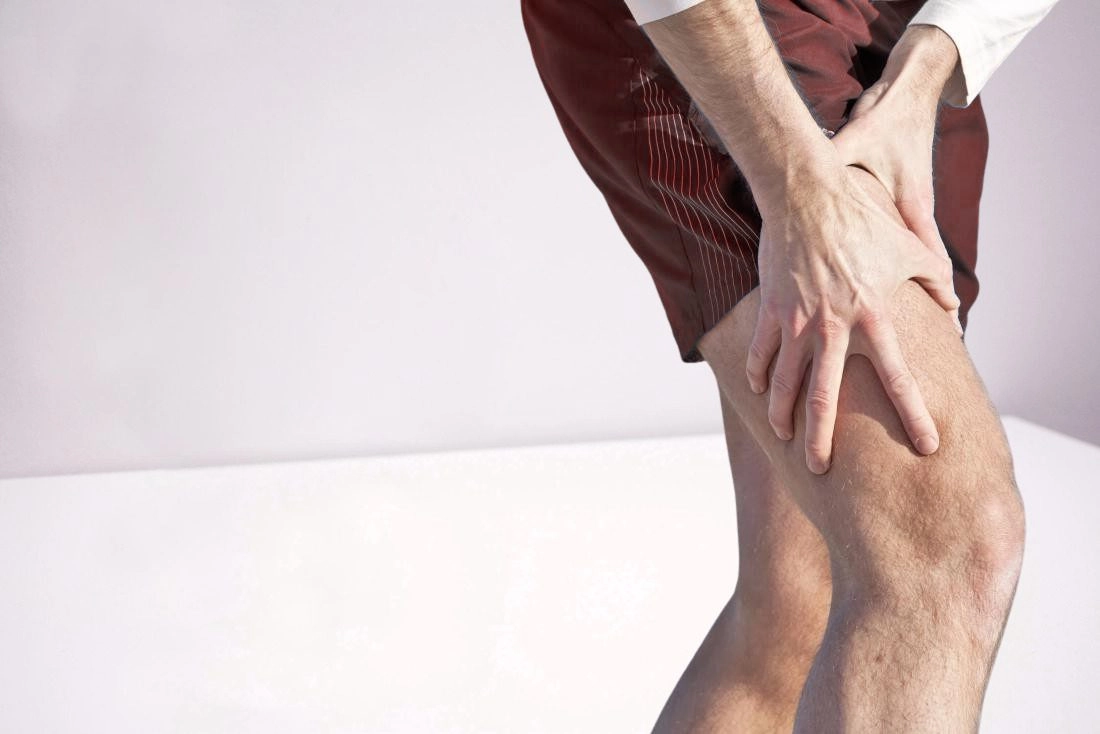The hamstrings are a group of three muscles that run down the back of each leg. Many people experience tight hamstrings, but not many people realize how much they can affect lower back pain.
The truth is that tight hamstrings can cause and exacerbate back pain and sciatica. The reason for this is how the hamstrings attach to the pelvis, which in turn affects the flexion of the lumbar spine. Anyone with back pain or sciatica should consider daily hamstring stretches as part of a relief program.
How Can Tight Hamstrings Cause Back Pain?
At a glance, it doesn’t look like tight hamstrings should be able to cause back pain. But if you’ve ever talked to a chiropractor, you’ve probably heard how interconnected the different muscles of the body are. This is one of the reasons chiropractors are good at helping lower back pain; they work on the basis that the body is one unit with lots of different parts.
The main purposes of the hamstrings are to bend the knee and allow it to rotate. But, they also play a part in allowing the hips to extend or tilt. Unfortunately, when the hamstrings are tight, they can pull the hips back and cause the lower back to bend slightly forwards. This pulls the spine out of its proper alignment.
While tight hamstrings alone may not cause back pain directly, they weaken the structure of the lower back, place undue pressure on the spinal discs, and open up the area to injury.
This is how tight hamstrings can cause non-specific low back pain. But what about sciatica?
How Can Tight Hamstrings Cause Sciatica?
Sciatica is usually caused by a bulging disc in the lower back which presses on the sciatic nerve. This is incredibly common and very uncomfortable. And the same tightness in the hamstrings that contributes to lower back pain can contribute to sciatica.
The reason for this has to do with the extra load that is put on the spine, especially when bending over. Bending with loose hamstrings will allow you to maintain an ideal posture by hinging at the hips and keeping a straight back.
If you have tight hamstrings, it will cause your lower back to bend, which puts strain on the discs. So, every time you bend over with tight hamstrings, you’re putting excess pressure on the discs, which can lead to sciatica.
This is why improper bending and lifting are things to avoid to prevent a sciatica flare-up. And you may think that stretching your hamstrings will help relieve your sciatica, but this isn’t necessarily the case. In fact, improperly stretching your hamstrings while you’re suffering from sciatica may worsen the symptoms.
There are good sciatica stretches and bad ones. More on that later. For now, let’s talk about sciatica and tight hamstring differences.
The Difference Between Sciatica and Tight Hamstrings
Since sciatica can cause pain down the back of the thigh, it’s often confused with tight hamstrings. It’s important to know whether your pain is caused by sciatica or tight hamstrings before you start attempting to relieve your pain.
Test Your Hamstrings
First you’ll want to test to see if you have tight hamstrings. This is an easy test you can perform at home. You’ll need a comfortable but sturdy place to lie down on your back, and a towel, long strap, or a belt.
- Grab your towel and roll it up lengthwise.
- Lie on your back with one leg straight out touching the floor.
- Bend the knee of your other leg and bring the other foot toward you. Wrap the middle of the towel around the arch of your foot and hold on to each end with both hands.
- Straighten the leg out in front of you, pulling back slightly with the towel to keep the tension in the leg. Make sure to keep the back of your head, shoulders, and your other leg in contact with the floor or mat.
- Raise the leg up as high as you can, aiming to get to a full 90-degrees, but don’t force it. If your knee wants to buckle and bend or you can’t go any further without raising your other leg off the mat, that’s as far as you can go.
If you managed to get your leg up between 70 and 90-degrees, your hamstrings are in the normal range and you’re likely suffering from a sciatic nerve issue. Any less than 70-degrees and your hamstrings are tight and could use proper stretching.
Test Your Sciatic Nerve
This test is very similar to the hamstring test above and it requires the same supplies.
- Lie on the floor and wrap the towel around your foot with your other leg straight out and touching the floor.
- As you bring your other leg straight and pull it toward you, point your toes toward your body and tuck your chin into your chest. This serves to tighten the sciatic nerve from both sides.
- Bring your leg up as high as you can. You generally won’t be able to get as high as you could with your hamstring test, but you’re looking for a range between 60 and 80-degrees.
If you feel pain, tingling, or numbness during either of these tests, stop them immediately and contact a chiropractor or physician. You should experience some tightness during the tests, but pain and numbness are both red flags that indicate something else is going on.
Why Are Your Hamstrings So Tight?
Many people wonder what causes tight hamstrings. There are a number of causes that typically involve overuse and underuse. Here are some of the top causes of hamstring tightness.
- Sitting for long periods.
- Lack of exercise.
- New exercises that involve the hamstring.
- Overuse – can happen to runners or those playing sports with lots of running and jumping.
- Sprain or strain – usually the result of a minor injury.

How Long Does It Take to Recover From Hamstring Tightness?
Hamstring tightness usually resolves within a week with proper stretching exercises. If you do nothing about your tight hamstrings, they may not go away or they may keep recurring. If your tight hamstrings are causing you more than just discomfort or they’re affecting your sleep, you should consider seeing a chiropractor or physical therapist.
Stretching twice a day can help resolve hamstring tightness. But remember to choose stretches that don’t require you to arch your lower back. The most common form of hamstring stretches is also the worst for your lower back: standing hamstring stretches. Instead, choose other options, such as the ones below.
Fastest Way to Loosen Tight Hamstrings
Properly stretching your hamstrings twice a day is the fastest way to loosen them. Remember that overstretching them can have a detrimental effect, so don’t overdo it.
Proper Standing Hamstring Stretch
This hamstring stretch doesn’t require you to bend over and round your back. It’s also easy to do pretty much anywhere, making it ideal for getting a quick stretch in.
- Find a chair or something below waist level.
- Place the heel of your foot on the chair and straighten the leg.
- Keep your back straight and lean slightly out over your outstretched leg while simultaneously bending your supporting leg into a small squat.
- Hold for a few seconds, then release back up.
- Repeat 8 to 12 times, twice a day.
Activities like yoga can also help keep your hamstrings loose. Weight workouts that target the hamstrings are also beneficial as they keep the hamstrings loose and strong. Some of these workouts include:
- Hamstring curls
- Deadlifts
- Calf raises
- Box jumps
- Lunges
Fastest Ways to Treat Sciatica
While treating tight hamstrings is a fairly straightforward prospect, taking care of sciatica fast can be a bit more complicated. Sciatic nerve pain treatment is best left to a chiropractor, physical therapist, massage therapist, or all three. This is because there are many different causes of sciatica. Tight hamstrings could be a culprit, but it could also be any number of other things.
A chiropractor can perform a thorough assessment to see what is causing your sciatica. Much of the time it’s a combination of factors including lifestyle, posture, and activity level. A doctor of chiropractic can also give you tips for sleeping with back pain and other ways to manage your sciatica effectively.
But, best of all, many people who see a chiropractor for sciatica experience relief in just one or two sessions. And since many chiropractors work with physical therapists and massage therapists, you can get the best of all worlds and experience the benefits of professional sciatica treatment.
Resources:
https://journals.sagepub.com/doi/abs/10.1177/036354658801600515
https://www.medicalnewstoday.com/articles/tight-hamstrings-symptoms-causes-and-treatments#causes
https://www.healthline.com/health/tight-hamstring
https://www.sciencedirect.com/science/article/abs/pii/S1529943005008338









